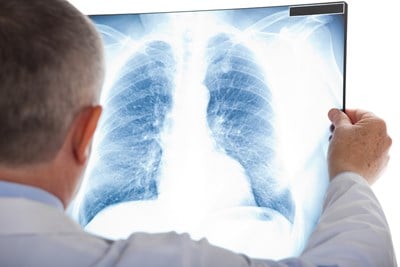A lung mucus plug occurs when too much of the naturally occurring mucus is present without being cleared away through the normal processes. Mucus plugs in the lungs generally develop in response to chronic underlying conditions of the respiratory or nervous system that weaken the lungs or surrounding muscles. They are, quite literally, a large collection of mucus that turns into a condensed glob in the respiratory passageways, potentially very far down in the lungs. Here’s a look at symptoms, causes, complications, and prevention of lung mucus plugs.
Symptoms and Causes
When a mucus plug develops, you may have difficulty breathing and chest pain. In a normal, healthy respiratory system, mucus is secreted to gather dust, dirt, and pathogens (bacteria and viruses) before they make it to the lungs. The cilia, or tiny hairs on the tissue surface, the wipe away the grime- and bacteria-laden mucus.
Occasionally, it may require a good cough to get rid of extensive mucus. However, conditions that affect the respiratory system like cystic fibrosis or asthma create an excess of mucus. The increased fragility of a patient's respiratory system makes mucus plugs more dangerous. Conversely, following surgery or for those with a nervous system condition like Lou Gehrig’s disease or spinal muscular atrophy, the difficulty lies in the inability to expel plugs once they form, because the weakness of throat, chest, and abdominal muscles produces an insufficient cough.
Complications
The danger of mucus plugs lies largely in the complications that may result. They may not block airflow completely, but they do often become large enough that not enough air is able to flow into the lungs, causing an airway obstruction or limitation. Several things may happen as a result. Hypoxemia, or low blood oxygen levels, may occur, evidenced by difficulty breathing, an increased breathing and heart rate, weakness, dizziness, or confusion. Atelectasis, a collapse of all or part of the lung, may also occur as a result of airway obstructions. Bronchiectasis may develop because of damage caused to passageways or airway defenses. Not only can airways become larger than they should (and never shrink back down), but the cilia and other parts may be damaged sufficiently to be unable to do their job. As a result of a combination of these things, respiratory failure may follow.
Prevention and Treatment
Prevention and treatment of mucus plugs is largely dependent upon the underlying cause of the mucus plug. In the case of disorders like asthma and cystic fibrosis, it’s extremely important to continue daily treatments intended to keep mucus at a minimum. Humidifiers may also help. During surgery and chronic respiratory assistance, healthcare professionals often use suction to remove excessive amounts of mucus. However this can continue after surgery, so caregivers must be informed about the most effective methods for managing this. When an inability to expel the mucus plug because of weakness, certain maneuvers and machines are available to assist caregivers in helping patients to cough sufficiently to clear the airways.




